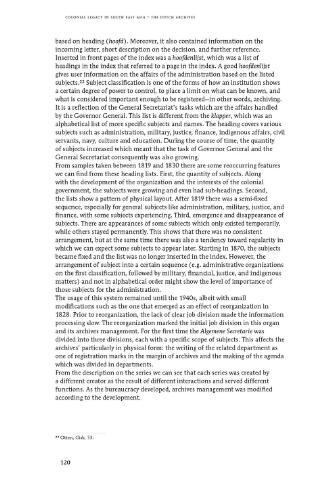based on heading (hoofd). Moreover, it also contained information on the
incoming letter, short description on the decision, and further reference.
Inserted in front pages of the index was a hoofdenlijst, which was a list of
headings in the index that referred to a page in the index. A good hoofdenlijst
gives user information on the affairs of the administration based on the listed
subjects.22 Subject classification is one of the forms of how an institution shows
a certain degree of power to control, to place a limit on what can be known, and
what is considered important enough to be registered—in other words, archiving.
It is a reflection of the General Secretariat's tasks which are the affairs handled
by the Governor General. This list is different from the klapper, which was an
alphabetical list of more specific subjects and names. The heading covers various
subjects such as administration, military, justice, finance, indigenous affairs, civil
servants, navy, culture and education. During the course of time, the quantity
of subjects increased which meant that the task of Governor General and the
General Secretariat consequently was also growing.
From samples taken between 1819 and 1830 there are some reoccurring features
we can find from these heading lists. First, the quantity of subjects. Along
with the development of the organization and the interests of the colonial
government, the subjects were growing and even had sub-headings. Second,
the lists show a pattern of physical layout. After 1819 there was a semi-fixed
sequence, especially for general subjects like administration, military, justice, and
finance, with some subjects experiencing. Third, emergence and disappearance of
subjects. There are appearances of some subjects which only existed temporarily,
while others stayed permanently. This shows that there was no consistent
arrangement, but at the same time there was also a tendency toward regularity in
which we can expect some subjects to appear later. Starting in 1870, the subjects
became fixed and the list was no longer inserted in the index. However, the
arrangement of subject into a certain sequence (e.g. administrative organizations
on the first classification, followed by military, financial, justice, and indigenous
matters) and not in alphabetical order might show the level of importance of
those subjects for the administration.
The usage of this system remained until the 1940s, albeit with small
modifications such as the one that emerged as an effect of reorganization in
1828. Prior to reorganization, the lack of clear job division made the information
processing slow. The reorganization marked the initial job division in this organ
and its archives management. For the first time the Algemene Secretarie was
divided into three divisions, each with a specific scope of subjects. This affects the
archives' particularly in physical form: the writing of the related department as
one of registration marks in the margin of archives and the making of the agenda
which was divided in departments.
From the description on the series we can see that each series was created by
a different creator as the result of different interactions and served different
functions. As the bureaucracy developed, archives management was modified
according to the development.
COLONIAL LEGACY IN SOUTH EAST ASIA -
THE DUTCH ARCHIVES
22 Otten, Gids, 53.
120

